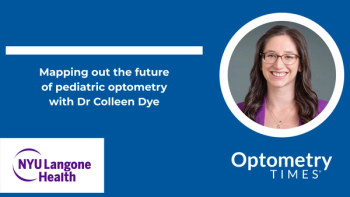
- September/October digital edition 2025
- Volume 17
- Issue 05
Exposure to green space linked to lower odds of dry eye disease development
Research reveals that increased exposure to green spaces significantly reduces the risk of developing dry eye disease, highlighting urban planning's vital role in public health.
A recent study assessed the association between exposure to green space and dry eye. According to first coauthors Weijing Cheng, MD, and Hanyou Wu, MD, greater 10-year green space exposure was associated significantly with lower odds of development of dry eye.1
Cheng and Wu are from the State Key Laboratory of Ophthalmology, Zhongshan Ophthalmic Center, Sun Yat-sen University; and Guangdong Provincial Key Laboratory of Ophthalmology and Visual Science, Guangdong Provincial Clinical Research Center for Ocular Diseases, Guangzhou, China.
"Dry eye is closely associated with environmental exposure and presents a significant risk to human visual health and quality of life,"2 the investigators commented.
Previous results have supported that environmental exposure is a culprit, with studies indicating the impact of air pollution and climatic factors. The air pollutants associated with dry eye primarily include particulate matter, nitrogen dioxide, ozone, sulfur dioxide, and carbon monoxide.3-7 Climatic culprits include temperature, humidity, and sunlight exposure.6-8
They cited a large study that found that the prevalence of dry eye disease is higher among urban residents than those in rural areas.5
"Urbanization has resulted in a decrease in green space despite its known positive impact on public health. Studies have demonstrated that green space exposure can mitigate the prevalence of mental health disorders, including anxiety, depression, and sleep disturbances, all of which are recognized risk factors for the onset of dry eye.9-11 Furthermore, studies have also reported that exposure to green spaces has positive effects on eye health, such as reducing the prevalence of myopia and the incidence of allergic conjunctivitis,"12,13 they explained.
In light of all the previous research, they wanted to determine if there was a relationship between green space and dry eye.
Dry eye study methods
The study under discussion included 2 parts: a case-control study and a cross-sectional study.
Part 1 included 450 patients with dry eye and 900 controls recruited from electronic health records database. The data were used to investigate the relationship between green space exposure and the occurrence of dry eye.
The cross-sectional segment included 140 patients with diabetes recruited from the community registry in Guangzhou. The data were analyzed to identify an association between green space exposure and quantitative measures of the tear meniscus.
What did the data analysis show?
Part 1 included a total of 1350 patients and controls, of whom 59.33% were female. The participants were an average age of 31.07 ± 4.58 years.
The investigators reported that “higher 10-year green space exposure was significantly associated with lower odds of dry eye (OR, 0.96; 95% CI, 0.94-0.97; P < .001) after adjusting for age, sex, rainfall, temperature, particulate matter, and other factors.
Part 2 comprised 140 patients with diabetes, of whom 53.57% were women. The average patient age was 64.48 ± 8.19 years. In this group, the investigators found that “greater 10-year green space exposure was associated with a higher tear meniscus area (β = 0.07; 95 % CI, 0.02-0.11; P = .007) after adjusting for the same factors as in Part 1.
Commentary
In commenting on their findings, the authors explained the significant public health implications of their results, specifically that “the potential protective effect of green space exposure on dry eye warrants consideration. Disparities in access to green space between urban residents in developed and developing countries are stark, with the latter having access to only one-third of the green space available to the former.14 This research underscores the need to enhance urban planning and management, improve urban spatial organization, and promote the equitable distribution of green space. Furthermore, future research on conditions such as dry eye should account for the potential influence of green space exposure.”
They continued, “Our research identified a negative relationship between green space exposure and dry eye. Urban planning decisions should thoroughly incorporate the design and functionality of green space to offer effective measures for preventing dry eye.”
References
- Cheng W, Wu H, Wang Z, Liang L. Association between long-term green space exposure and dry eye in China. Asia-Pac J Ophthalmol. 2025;14:100165.
https://doi.org/10.1016/j.apjo.2025.100165 - Moss SE, Klein R, Klein B. Prevalence of and risk factors for dry eye syndrome. Arch Ophthalmol. 2000;118:1264-1268.
- McDonald M, Patel DA, Keith MS, et al. Economic and humanistic burden of dry eye disease in Europe, North America, and Asia: a systematic literature review. Ocul Surf. 2016;14:144-167.
- Lu C-W, Fu J, Liu X, et al. Impacts of air pollution and meteorological conditions on dry eye disease among residents in a northeastern Chinese metropolis: a six-year crossover study in a cold region. Light Sci Appl. 2023;12.
- Yu D, Deng Q, Wang J, et al. Air pollutants are associated with dry eye disease in urban ophthalmic outpatients: a prevalence study in China. J Transl Med. 2019;17:46-49.
- Um SB, Kim NH, Lee HK, et al. Spatial epidemiology of dry eye disease: findings from South Korea. Int J Health Geogr. 2014;13:31.
- Mo Z, Fu Q, Lyu D, et al. Impacts of air pollution on dry eye disease among residents in Hangzhou, China: a case-crossover study. Environ Pollut. 2019;246:183-189.
- Hwang SH, Choi Y, Paik HJ, et al. Potential importance of ozone in the association between outdoor air pollution and dry eye disease in South Korea. JAMA Ophthalmol. 2016;134:503.
- Tandon R, Vashist, Gupta N, et al. Association of dry eye disease and sun exposure in geographically diverse adult (≥40 years) populations of India: The SEED (sun exposure, environment and dry eye disease) study - Second report of the ICMR-EYE SEE study group. Ocul Surf. 2020;18:718-730.
- Chen B, Wu S, Song Y, et al. Contrasting inequality in human exposure to greenspace between cities of global north and global south. Nat Commun. 2022;4636.
- Peng BA, Naduvilath TJ, Flitcroft DI, et al. Is myopia prevalence related to outdoor green space? Ophthalmic Physiol Opt. 2021;41:1371-1381.
- Yang Y, Chen W, Xu A, et al. Spatial technology assessment of green space exposure and myopia. Ophthalmology. 2022;29:113-117.
- Lin L, Chen Y, Wei J, et al. The associations between residential greenness and allergic diseases in Chinese toddlers: A birth cohort study. Environ Res. 2022;214:114003
- Klohe K, Koudou BG, Fenwick A, et al.A systematic literature review of schistosomiasis in urban and peri-urban settings. PLoS Negl Trop Dis. 2021;15:e0008995
Articles in this issue
about 1 month ago
What a pharmaceutical representative taught me about glaucoma dropsabout 1 month ago
AI glasses fill in gaps for patients with low visionNewsletter
Want more insights like this? Subscribe to Optometry Times and get clinical pearls and practice tips delivered straight to your inbox.



















































.png)


